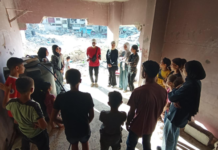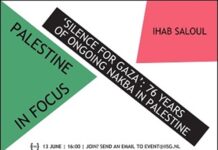Jason Burke
The Observer / July 13, 2024
As a terrorist attack, a harsh response and an ensuing invasion strike familiar chords, analysts look for lessons from the war of 42 years ago.
It started with a terrorist attack, which triggered massive military retaliation, the siege of a city, the deaths of thousands of civilians and devastation and global outrage. If the military operation was a success in tactical terms, it led to strategic failures that scarred the nation and the region for decades to come.
Sounds familiar? Forty-two years later, as a new conflict looms on Israel’s northern borders, historians, analysts and veterans of Israel’s 1982 invasion of Lebanon are looking to that now-distant war for lessons and warnings.
Inevitably, much was very different back on the summer’s day when a gunman sent to London by a Palestinian breakaway faction in the pay of Saddam Hussein narrowly failed to kill Shlomo Argov, the Israeli ambassador to the UK, as he left a dinner at the Dorchester hotel. The cold war was at its chilliest for decades; the main threat to Israel from across its northern frontier was the Palestine Liberation Organization (PLO), then led by Yasser Arafat and though the Iranian revolution of 1979 had made clear the new power of political Islamism, few thought resurgent religion could pose a real danger to Israel.
But if many differences are clear, there are some obvious parallels too, perhaps confirming the adage that if history doesn’t repeat itself, it can rhyme.
Israel in 1982 was led by Menachem Begin, a populist hardliner whose first electoral victory five years earlier had ended decades of leftist rule and signaled the country’s swing to the right. Begin’s defence minister in 1982 was the controversial general turned politician, Ariel Sharon. One of Israel’s most successful – some say gifted – and ruthless military commanders, Sharon had ambitious plans.
The PLO’s various factions had been responsible for very many terrorist attacks against Israeli and other targets around the world over the previous decade. Some were well known – such as the bloody attack on the Israeli team at the Munich Olympics in 1972, or that which led to Israeli special forces’ rescue operation at Entebbe, Uganda in 1976. But by 1982, such attacks were at an ebb well below the high tide of the mid-1970s.
This is one major difference with the current situation. Between 1980 and 1981, the total casualties from the actions of Palestinian armed factions in Israel, the West Bank and Gaza had been just 16 dead and 136 wounded. This could hardly be considered an existential danger. In contrast, the Hamas attack into Israel last October which triggered the current conflict in Gaza killed 1,200, mostly civilians. About 250 were abducted.
The shooting of Argov in June 1982, historians now largely agree, provided the pretext that Begin and Sharon were waiting for. When told by intelligence officials that the ambassador’s would-be assassin had been dispatched by a group that had enthusiastically killed many of Arafat’s closest aides and allies, Begin and top military officials were unimpressed. “Abu Nidal, Abu Schmidal, they are all PLO,” chief of staff Rafael Eitan said.
Within 10 days of invading Lebanon, the Israeli army had arrived outside Beirut, effectively surrounding Arafat and his PLO fighters. A fierce bombardment was directed at the city’s western neighbourhoods, the PLO stronghold.
“We did in Beirut exactly what we are doing in Gaza. We turned off the water, the electricity, everything. But there was no social media so people didn’t know so much,” said Dr Ahron Bregman, an expert at King’s College London who served as an Israeli soldier during the 1982 conflict.
The siege of Beirut lasted more than two months, and cost many thousands of civilian lives. The exact toll was, and is, disputed. So too, as with this current war, was the proportion of civilians killed. But even the highest estimates – 20,000 dead – are far lower than those for Gaza now, where the toll has passed 38,000, according to Palestinian officials. The physical destruction in Gaza is also on a totally different scale.
“Units today have so much more firepower. Then we just had machine guns, light anti-tank weapons and grenade launchers,” said Ariel O’Sullivan, a well-known Israeli journalist who fought as an infantryman.
One complaint from Israel about that earlier conflict is familiar. Arafat had sited his command bunkers under apartment blocks sometimes inhabited by those displaced by the fighting. “Beirut’s buildings were our barricades,” wrote one PLO official years later. Israeli spokespersons accused the organization of using civilians as human shields, a charge it denied.
Arafat knew that Sharon would aim to reach Beirut and that his ramshackle forces would be swept aside by the juggernaut of the Israel military, which had been re-equipped with vast quantities of state-of-the-art US weapons and equipment since the 1973 war against Egypt and Syria. But he thought the UN would step in after just a few days as it had done in 1967 and 1979.
What transpired was rather different. Sharon had flown to Washington to seek prior approval for an invasion from Ronald Reagan’s administration well before Argov’s attempted assassination. But he received only a very half-hearted amber light from the hawkish secretary of state, Alexander Haig, a convinced anti-communist who believed much global terrorism was the work of the Soviet Union.
But once the war was under way, and this too is familiar, there were little more than weak calls for restraint from Reagan’s officials, and a continuing flow of ammunition. Protests that US-supplied weapons were being used illegally by Israel were brushed aside and the US vetoed UN resolutions that would have halted the Israeli advance.
Eventually, with networks broadcasting images of carnage into US living rooms ever night, Reagan called Begin, saying: “This is a holocaust.” Begin, much of whose family had been killed by the Germans during the second world war, demurred, but did as Reagan asked. These days, the US wields no such influence over Benjamin Netanyahu.
Roughly two weeks later, the PLO’s thousands of fighters left Lebanon for destinations across the Middle East, with Arafat departing to Tunis, some 2,000 miles away.
In an editorial in the The New York Times published even before the PLO chairman had left Beirut, Sharon boasted of “the crushing defeat” inflicted on the PLO. “The kingdom of terror that the PLO had established on Lebanese soil” had been destroyed, “international terrorism dealt a mortal blow” and the “whole infrastructure of violence and revolution … broken,” he told readers. The language was carefully chosen to frame the Israeli campaign as a cold war battle – and a rare one that had been unequivocally won. Israel’s efforts were, “a victory for peace and freedom everywhere,” Sharon wrote.
But any celebrations were short-lived. A Syrian bomb killed Pierre Gemayel, a Christian warlord who had recently been elected president of Lebanon and whom Sharon had hoped would rule as an Israeli client. Forty-eight hours later, Gemayel’s militia massacred between 700 and 3,500 Palestinian civilians in the Sabra and Shatila camps as Israeli troops fired flares which illuminated its bloody work.
What happened next in the region is instructive, veterans, analysts and historians say.
Within a year, the Israeli army had been drawn into a new brutal war against an insurgent force. Casualties had been relatively low during the initial offensive in Lebanon. Now they rose steadily as ill-equipped soldiers tried to quell a growing insurgency. Two suicide car-bombs, among the first ever deployed, would devastate bases in the southern town of Sidon. Hit-and-run attacks by an elusive enemy would kill more soldiers. An 18-year occupation would bleed Israel of its young men and resources, until an ignominious withdrawal in 2000. Many civilians died too.
“The lesson is the same then as it is today: If you can’t see what victory looks like, there can be no victory,” said Haim Har-Zahav, who served in Lebanon in the late 1990s and wrote a book about the forgotten later years of the conflict there.
The enemy Israel battled against for so long was Hezbollah, the Iran-backed Islamist militant movement founded in the aftermath of the invasion of 1982. In 2006, Hezbollah fought Israel’s military to a stalemate. Now, after opening fire on Israel on the morning after the surprise Hamas attacks in October, it is engaged in an escalating war of attrition with Israel, and may well be the target of a new Israel offensive within weeks.
Around 30 Israelis have been killed, around half civilians, by the attacks in the north. Israel has evacuated 60,000 people from the border zone and retaliated with artillery and air strikes that have killed an estimated 450, including nearly 100 civilians.
Most analysts agree that neither side want a war, but that avoiding a devastating clash might be impossible.
The first Lebanon war changed Israel and the region. Now an Israel changed dramatically by the October attack faces a new conflict on an old battlefield.
Jason Burke is the International security correspondent of The Guardian












